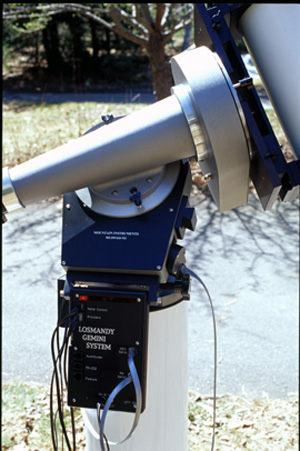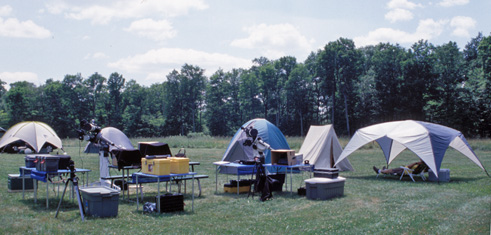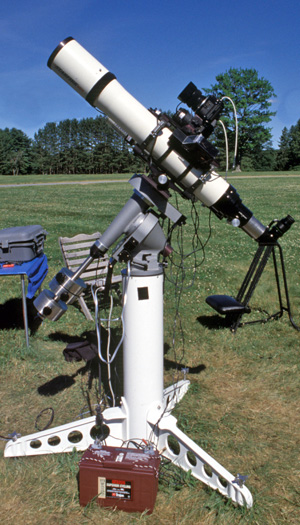Imaging Excursion to Cherry Springs State Park, Pennsylvania
July 5 – 13, 2002
July 5 – 13, 2002
George Whitney and I packed up the trailer and relocated the newly downsized Whitney Repository to do a bit of imaging in the mountains of north central Pennsylvania. We’d read and heard from fellow imagers as well as visual observers about Cherry Springs State Park, indicating this as one of the darkest sites in the east. The park was recently designated a ‘dark sky park’ in a new program being instituted across the country. What this meant in this case is that the site has free camping in the field next to your equipment over new moon periods. The park is also being promoted to the general public and both weekends we were encamped found visitors coming in at designated times.

We found this part of Pennsylvania surprisingly rural, out in the middle of nowhere actually. Hunting, fishing, hiking, viewing wildlife, astronomy to a small degree, ATV riding in warm weather and snowmobiling in cold, appear to be the primary recreation pursuits in the area. The nearest town of consequence was Coudersport (yes, The Coudersport, home of Adelphia, a company in big trouble these days) about 15 miles from our site. The Park offers two chemical toilets, several post mounted cooking grills, a pavilion structure that can be utilized by reservation, water at certain locations and little more in form of amenities. We found an outlet behind the restroom building that was live and used this to charge our deep cycle batteries. We’d transported a small, extremely quiet, Honda generator we purchased just for the purpose of charging and used it some as well. If you want to get away from landlines and cell phones, this is a good place to do it; there is no cell phone reception at the site. Across from the park is a small grass airstrip that is still in use. There’s a post-mounted telephone there, the only public phone for miles around as far as we could tell.
Our pre-trip research indicated there’s a camp area about 20 minutes away where you can take a shower for a few bucks (there are state parks, large and small everywhere in this area). Upon investigation, we found a private campground about 8 miles away where you could shower for $3.00. We found the $3 and time to make the drive well worth the effort after a long night; this was the nearest shower from our location.
As the new moon occurred at 06:27 on Wednesday (July 10th), both weekends were fairly active and the number of astronomers present surprised us the Friday we arrived, perhaps 30 or 40 set ups of various equipment types at all levels of excellence. This wasn’t a formalized, advertised star party and as our goal was imaging, we hoped it would be less active and quiet. This looks like ‘big dob’ country and there were many dedicated dob observers that we later found are regulars.
The first night upon arrival, Friday, July 5th found decent sky conditions. We were set up before dark and had completed a lengthy, precision drift polar alignment on the mounts around midnight. At this point we were ready to break out the autoguiders, load film in the cameras and start to image. One significant problem arose however; we left Portland at 03:00, drove 577 miles in just under twelve hours and I was so tired after pre-trip preparations, the early start and arrival set up, I needed to get some sleep. Over the next few days I came to regret this decision.
Before going on I should point out that this trip was the ‘official’ debut of George’s new ‘super-system’. This consists of an AP 1200 Goto mount (this monster has a conservative 150 pound payload), a side-by- side mounting system with an Astro-Physics 155 EDF f7 triplet refractor on one side and a A-P 105mm Traveler, an f6 Christen triplet, on the other. This assembly, along with my MI-250 Goto, also mounting two f8 refractors at 130mm & 78mm, became the focal point of the area and we had many visitors. We came to realize that those ‘crazy guys from Maine’ were being discussed and known in the camping area (they must have been talking about George

